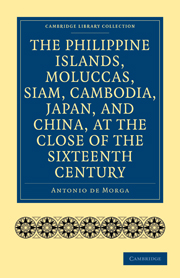Book contents
- Frontmatter
- TRANSLATOR'S PREFACE
- SUCESOS DE LAS ISLAS PHILIPINAS DIRIGIDOS
- IMPRIMATUR
- DEDICATION
- TO THE READER
- CHAPTER I
- CHAPTER II
- CHAPTER III
- CHAPTER IV
- CHAPTER V
- CHAPTER VI
- CHAPTER VII
- CHAPTER VIII
- APPENDIX I
- APPENDIX II
- APPENDIX III
- APPENDIX IV
- APPENDIX V
- APPENDIX VI
- INDEX AND GLOSSARY
- Plate section
CHAPTER VIII
Published online by Cambridge University Press: 05 October 2010
- Frontmatter
- TRANSLATOR'S PREFACE
- SUCESOS DE LAS ISLAS PHILIPINAS DIRIGIDOS
- IMPRIMATUR
- DEDICATION
- TO THE READER
- CHAPTER I
- CHAPTER II
- CHAPTER III
- CHAPTER IV
- CHAPTER V
- CHAPTER VI
- CHAPTER VII
- CHAPTER VIII
- APPENDIX I
- APPENDIX II
- APPENDIX III
- APPENDIX IV
- APPENDIX V
- APPENDIX VI
- INDEX AND GLOSSARY
- Plate section
Summary
Account of the Philippine Islands, and of their Inhabitants, Antiquity, Customs, and Government, both during the time of their paganism, and since the Spanish conquest, with other particulars.
The isles of the eastern ocean, adjacent to further Asia, belonging to the crown of Spain, by the demarcation of Castile, and her seas and countries of America, are commonly called by those who navigate to them the western isles; because from first leaving Spain, until reaching them, the navigation to them is by the path which the sun follows from east to west, and for the same reason, they are called eastern by those who navigate by way of Portuguese India, from west to east: both encircling the world by opposite voyages, until they come and meet in these islands, for they are many between great and small, which are properly called Philippines, and are subjected to the crown of Castile. They are within the tropic of Cancer, and extend from twenty-four degrees north latitude, as far as the equinoctial line, which passes through the islands of Maluco. There are many others on the side of the line, in the tropic of Capricorn, which extend as far as twelve degrees towards the south. The ancients affirmed, that one and all they were desolate and uninhabited; now experience has shown that they had been mistaken, there being found in them good climates, many peoples, provisions and other things convenient for human life: with many minerals, rich metals, gems and pearls, animals and plants, of which nature has not been sparing.
- Type
- Chapter
- Information
- The Philippine Islands, Moluccas, Siam, Cambodia, Japan, and China, at the Close of the Sixteenth Century , pp. 265 - 358Publisher: Cambridge University PressPrint publication year: 2010First published in: 1868

